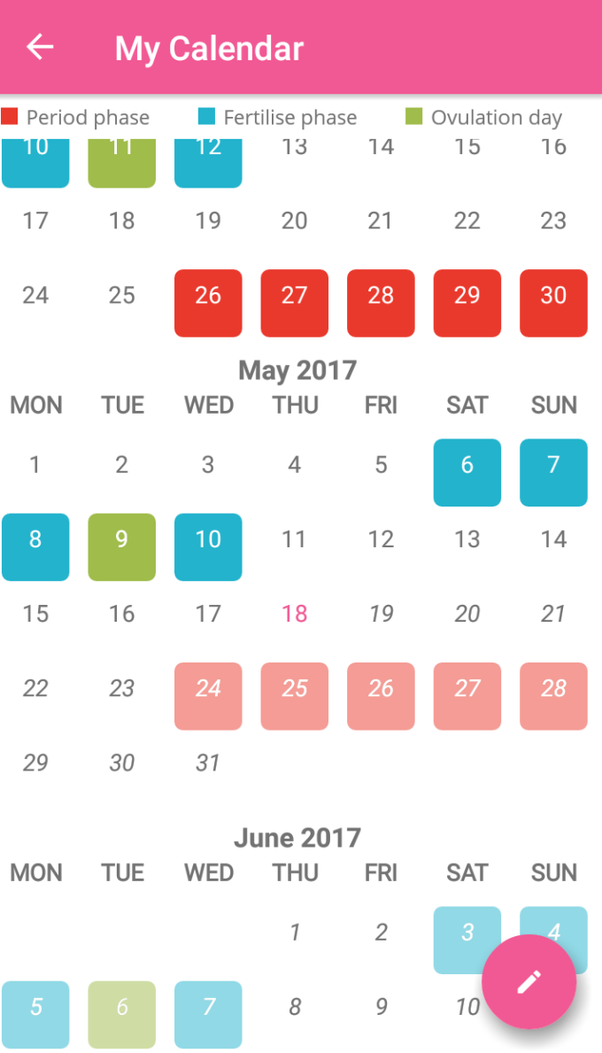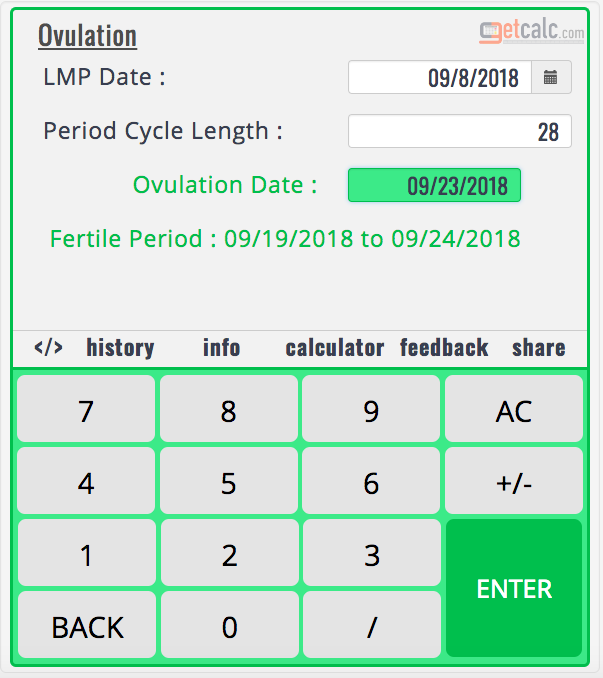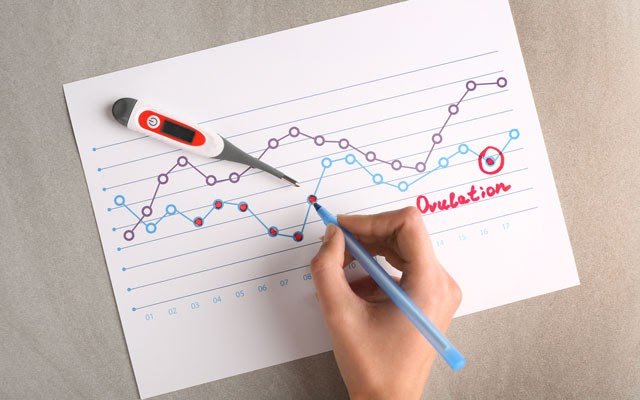How Does Late Ovulation Affect Your Chances Of Getting Pregnant
If you have long, irregular cycles, it can be really hard to know if and when youre ovulating which means it can be hard to time sex so egg and sperm meet. The good news is, your eggs themselves are likely just fine. PCOS, hyperprolactinemia and hypothyroidism are all treatable with medications, which makes ovulation more regular and greatly improves your chances of getting pregnant.
In the extremely rare case that you dont have any of these conditions but just have a short luteal phase, some doctors think that the uterus may not have enough time between cycles to build up its lining for an embryo to attach. That could theoretically lower your odds of getting pregnant, but its far from certain.
How To Predict When Menstruation Will Occur Next
Now, you can calculate your period cycle length and know if its regular or not. If your period cycle is 28 days and regular, count forward 28 days from the first day of last period to get your expected next period.
Lets say your period is regular and comes every 28 days. If today is 1st of March and your period started now, you can predict your next period to start on the 29th of March. Easy, right?
Calculate Your Fertile Window
To calculate your Fertile Window, you need to determine what day you ovulate.To do this, you need to know the length of your menstrual cycle . To calculate this you should note how many days have passed from the first day of bleeding in your last period, to the first day of bleeding in your next.From this figure, subtract 14 days from the end of your current cycle to determine the day you ovulate.If you have irregular menstrual cycles, or your cycle length varies from month to month, it will be difficult to calculate your ovulation date. Ovulation urine tests may be useful, and you should consider seeking further advice from your GP or a Fertility Specialist.
Don’t Miss: Over The Counter Pills To Stop Period
How Long After Period Do You Ovulate
Now we know what period cycle means, how to predict next period and how to know next ovulation date.
Next, how to calculate how many days after period do you ovulate.
Period length can vary from woman to woman. Most women have period for about 5 days. It possible your period is shorter or longer. However, normal length for period is two to seven days.
Infrequent Periods / Infrequent Ovulation

If you are not ovulating regularly, you will have reduced opportunities to conceive, or if your periods are irregular, it may be difficult to calculate your fertile window.
There can be many reasons for infrequent or occasional periods or no periods at all. Some causes are natural, while others are medical conditions that need to be treated.
Recommended Reading: How To Stop Your Period Pain
What Is An Ovulation Calculator And How Does It Help You Get Pregnant
An ovulation calculator helps you to estimate how likely you are to ovulate on certain days in your cycle so you can identify your most fertile days, the ones that are prime for conception. These calculators work by taking the first day of your last period and the length of that menstrual cycle to give a range of days when you may release an egg.
“Some people find it reassuring to monitor signs of ovulation and feel confident they are taking control over boosting their fertility.” Dr Matthew Prior says. He goes on to add, “However, some research shows that getting too hung up on your cycle can cause more stress and take away the enjoyment of trying to conceive causing unnecessary pressure. If this is the case it may be a good idea to stop monitoring for a few months.”
Tracking Ovulation To Find Your Fertile Window
There are many methods of tracking and predicting ovulation so you can try to figure out when you are most fertile. An ovulation day calculator may provide an estimate, but isn’t always the most accurate of methods, especially if you have irregular periods.
Some ways to try to pinpoint your ovulation period at home include over-the-counter ovulation predictor kits, body basal temperature charting, and checking for fertile cervical mucus.
Ovulation predictor kits increase your chance of getting pregnant by 40%, according to a review of research. Each kit comes with five or so test strips or sticks, and manufacturers typically recommend you test your urine for several days leading up to your suspected ovulation day. This makes this method can potentially costly, especially if you have somewhat irregular periods and you have to test for many days on end.
Among no-cost home ovulation-tracking methods, checking the texture of your cervical mucus may work best. According to research, people who had sex when they had slippery, egg-white-like cervical mucus were two to three times more likely to conceive than those who had scant or absent mucus secretions .
Don’t Miss: Foods To Eat When Your On Your Period
When Precisely Are You Most Fertile
If you are trying to conceive, APA suggests having intercourse every other day in this window. If you are trying to prevent pregnancy, avoid sex within this window and the 3-5 days before, or at least ensure you are using a form of birth control consistently and correctly.
Improve your ability to get pregnant with the ultimate Fertility Resource Guide. Our easy-to-understand e-book gives you essential information and tips on how to boost your fertility and get pregnant faster. Its a free download that includes a bonus offer of free Nightfood Nighttime ice cream.
How To Use This Ovulation Calendar Tool
- Pick a date on the calendar that matches the day you started your last period
- The calendar will display your estimated ovulation date, marking it in red.
- The days leading up to your ovulation date will appear marked in purple those are the days you are likely the most fertile.
- If you have records of how long your own menstrual cycle lasts, change the default number of 28 days in the dropdown menu in the results box for a more accurate calculation.
Recommended Reading: Could I Get Pregnant On My Period
How Does This Period Calculator Work
This great tool can determine the most important data of your cycle for you, from the fertile days to the period days in your menstrual activity.
The period calculator takes account of the first day of your last menstrual period, the menstrual cycle length and the length of the period.
As you provide this data, by simply pressing the calculate button the form will display you personalized information for the next 12 menstrual cycles on terms of the most fertile days, period start and period end and you can change the data input for as many times as you want with the reset button.
Ovulation Calculator: How Do You Calculate Your Ovulation Day
Calculating your ovulation day is a bit simpler, because ovulation only usually occurs on one day each month.
Assuming a luteal phase of 14 days, your ovulation day will be 14 days before your next expected period. For a 28-day cycle, your egg would be released on day 14.
If your luteal phase or cycle length are different than the average, plug your information into our accurate ovulation calculator to get your specific ovulation and fertility predictions.
Read Also: How To Get Period Blood Out Of Jeans
Changes In Basal Body Temperature
Basal body temperature is the temperature of the body at rest. For the most accurate reading, a person should take it as soon as they wake up.
During ovulation, this temperature may slightly increase as the body secretes progesterone, a hormone that helps thicken the uterine lining in preparation for the implantation of an embryo.
Before ovulation, a persons oral temperature is around 9698ºF . This may rise to 9799°F after ovulation. Because the increase is so slight, around 0.4 to 0.8°F, a person needs a special tool, a basal body thermometer, to detect it.
People are at their most fertile 23 days before their BBT is at its highest point and 1224 hours after ovulation.
Because BBT only rises after ovulation, people may prefer other ways of checking their fertility, such as tests that measure levels of luteinizing hormone in urine.
Also, it is important to note that other factors can raise a persons BBT, including:
- consuming alcohol
- having a fever
What Is An Ovulation Calendar And How Do You Use One

An ovulation calendar is a tool used to help identify your most fertile days, it can also help you to track your menstrual cycle. After working out the ovulation date using the calculator, many couples turn to an ovulation calendar – sometimes known as a fertility calendar – to figure out the days of the month where they’re most likely to conceive if they have sex.
It works as sperm can live in the body for up to five days after sex, so conception can occur even if you’ve had sex four or five days before ovulation begins. The fertility window is normally around six days, as that is the amount of days that the egg and sperm can survive. To figure out this fertile period, plot your menstrual cycle on a calendar then count back 14 days from the expected last day of your next cycle. This will be your most fertile day.
Alternatively, there are a number of apps that will do this for you – such as Clue.
Read Also: Can I Still Ovulate Without A Period
On Average Ovulation Occurs Within The 4 Days Before Or After The Midpoint Of A Womans Menstrual Cycle 14 Days Before The Start Of A Womans Next Menstrual Period
How long do you ovulate. It can be kind of confusing since people. This ovulation calculator provides an estimate of your fertile window and is not a. There are about 6 days during each menstrual cycle when you can get pregnant. If a womans cycle is longer or shorter than 28 days the predicted ovulation date is changed accordingly. How long do you ovulate.
When Does Conception Take Place
Conception starts at the moment of fertilisation, when the sperm penetrates the outer shell of the egg, and an embryo is formed. Over the next four to six days the embryo moves down the fallopian tube to the uterus, where it implants in the uterus lining and hopefully continues to grow. To check if you are pregnant, you should wait two weeks after ovulation before undertaking a pregnancy test.
Don’t Miss: What To Eat When Your On Your Period
What Is The Cervical Mucus Method Of Determining Fertility
The cervical mucus method involves being aware of the changes in your cervical mucus throughout the month. The hormones that control the menstrual cycle also change the kind and amount of mucus you have before and during ovulation.
Right after your period, there are usually a few days when there is no mucus present or “dry days.” As the egg starts to mature, mucus increases in the vagina, appears at the vaginal opening, and is white or yellow and cloudy and sticky. The greatest amount of mucus appears just before ovulation. During these “wet days” it becomes clear and slippery, like raw egg whites. Sometimes it can be stretched apart.
This is when you are most fertile. About four days after the wet days begin the mucus changes again. There will be much less and it becomes sticky and cloudy. You might have a few more dry days before your period returns. Describe changes in your mucus on a calendar. Label the days, “Sticky,””Dry,” or “Wet.” You are most fertile at the first sign of wetness after your period or a day or two before wetness begins.
The cervical mucus method is less reliable for some women. Women who are breastfeeding, taking hormonal birth control , using feminine hygiene products, have vaginitis or sexually transmitted infections , or have had surgery on the cervix should not rely on this method.
What Does Ovulation Mean And How Do You Know If Youre Ovulating
Knowing your monthly cycle will help you determine when youre ovulating.
To calculate your monthly cycle, you would count from the first day of your period, up to the first day of your next period.
So, the day you get your period is Day 1 of your cycle, and then you would count every day until your period starts again.
A typical menstrual cycle is 28-days. But this can vary in women. Some women can have a 27-day cycle, others a 35-day cycle. Its perfectly normal for a cycle to be anything between 21 to 35 days. Thats why its essential we treat each patient individually.
Read Also: Is It Safe To Have Sex On Your Period
How Else Can I Tell If I Am Fertile
Of course, working out your ovulation period using just your cycle dates can sometimes be inaccurate. During your menstrual cycle, hormones like estrogen and progesterone fluctuates. These fluctuations affects your body. Therefore, you can also track your ovulation by paying close attention to your body changes. This technique can also be used if you have irregular menstrual cycle . Charting these changes onto a calender would be most helpful as it will reveal a pattern that can assist in pregnancy or avoiding one.
- Changes in cervical mucus
Around the time of your ovulation, you may notice that your vagina mucus increases in amount. It becomes clear, stretchy and slippery, and can be said to have the consistency of egg white. This occurs because of the increasing estrogen levels in your body and occurs 3 days prior to Peak, when there would be a sudden change of vagina mucus consistency from slippery to non slippery. Peak is the last day when your vagina mucus is slippery. The ovulation period correlates to Peak and up to 2 days past Peak.
- Changes in body temperature
Your basal body temperature is best measured before you get out of bed, around the same time each day. Your BBT will rise about 0.5 degree Celsius from the baseline, after ovulation has taken place. Although the ovulation period would then have passed, charting your temperature will allow you to figure out your pattern of ovulation and guide you the following month.
- Ovulation or breast pain
What Is A Menstrual Cycle
Hint, it is more than just your period. The menstrual cycle is a series of changes a womans body goes through each month whereby the ovary releases an egg and the uterus prepares for pregnancy. The cycle can be divided into two phases: the follicular phase and the luteal phase.
The first day of your menses or period is day 1 of your cycle and the start of the follicular phase. During this phase, follicle stimulating hormone , is released from the brain to stimulate the development of a single dominant follicle which contains one egg. During its maturation, the follicle releases estrogen which stimulates growth and thickening of the uterine lining. The follicular phase concludes at the start of ovulation the process of releasing a mature egg from the dominant follicle. The length of the follicular phase is variable between individuals, resulting in most variations of total cycle length.
The luteal phase starts after ovulation and continues until the onset of the next menses. During this phase, the ovary releases progesterone which changes the uterine lining and opens the window of implantation the time during which the embryo can attach to the uterus. If pregnancy does not occur, the progesterone level drops and bleeding occurs. The luteal phase is usually between 12-14 days.
Also Check: What’s Best For Period Cramps
Response 11th February 2016 From Shanna
Same over here
Hi Kate
These questions are right where I am. Your answers are really the most helpful info Ive read in the past two years. Ive had saliva hormone tests done and they came back ok. Very slightly low progesterone. I have acne on my back, its horrible!! I have been gluten free for 4+ years, relatively clean diet. How can I get more info from you? Can I email you? Thank you, very much.
What Is A Luteal Phase

The luteal phase is the second half of your menstrual cycle, beginning at ovulation and ending with a new period or pregnancy. This is when you have a huge surge of three important hormones:
- Follicle stimulating hormone: Is released into your bloodstream by the pituitary gland to stimulate ovarian follicles to secrete estrogen and produce a mature egg .
- Luteinizing hormone: Is also released into your bloodstream by the pituitary gland in response to rising estrogen levels. This important hormone triggers the ovarian follicle to release the egg for potential fertilization.
- Progesterone: While estrogen plummets with ovulation, progesterone begins its climb to help nourish and thicken your uterine lining for potential egg implantation. Your progesterone levels will continue to rise if you become pregnant, as it literally helps to pro-gest your fertilized egg.
Don’t Miss: Why Do Women Get Period Cramps
Can You Only Get Pregnant When You Ovulate
Yes, you need to ovulate to be able to get pregnant, since by definition, it is the time the egg is released. A cycle without ovulation cant produce a pregnancy, but you dont have to be ovulating at the time of intercourse. Since sperm can live for up to 5 days in a womans reproductive tract and an egg can live for up to 24 hours, the time that intercourse can result in pregnancy is at least a 6-day window. An ovulation calculator can help you figure out what days you are most likely to get pregnant.
